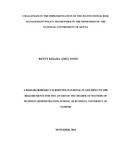| dc.description.abstract | The study was undertaken on the 18 ministries of the national government as per the Executive Order No 2/2013. These ministries play a key role in the economy by creating an enabling environment and providing basic facilities that spur economic growth and national development. The ministries are entrusted with vast resources to enable them deliver their specific mandates that together contribute to the Kenya Vision 2030, a blue print for national development. However, in pursuit of their mandates, they encounter risks that lead to poor performance as reported in the Kenya Economic Survey 2000-2013 hence the need for the Institutional Risk Management Policy Framework (IRMPF).The IRMPF was launched in the national government vide Treasury Circular No 3/2009 however five years down the line, the effectiveness of the IRMPF implementation has not been felt. The study therefore sought to identify the challenges encountered in the implementation of the IRMPF in these ministries. The study was a census on all the 18 ministries with a target population of 54 senior officers sampled on a purposive basis of three officers from each ministry. Primary data was sourced using questionnaires and secondary data was sourced using desk reviews. Data analysis was done using the Statistical Package for Social and Scientists (SPSS). The study established that the IRMPF roll out had commenced only in some ministries however, the progress was not remarkable as only 10 percent indicated that they had the IRMPF in place. All the ministries confirmed having several challenges across the board. Management buy in and leadership skills, scheduling and sequencing of activities, value creation by corporate parenthood, change management and dilemma of strategic choice were a common experience to all the ministries. The study concludes that the IRMPF implementation was not properly understood by the key players. Strategies and models to guide the implementation were also lacking. It also lacked a feedback mechanism to inform on the challenges for appropriate corrective actions. The study recommends a re-engineering of the IRMPF roll out by the National Treasury by sensitizing the top management and ensuring that the programme is guided and monitored. Other studies should establish the quality of documents and reports produced | en_US |

